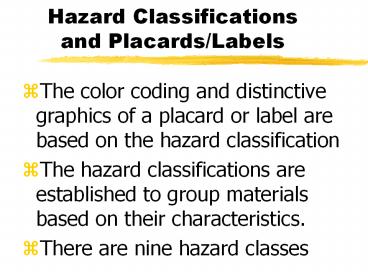Hazard Classifications and Placards/Labels - PowerPoint PPT Presentation
1 / 16
Title:
Hazard Classifications and Placards/Labels
Description:
Hazard Classifications and Placards/Labels The color coding and distinctive graphics of a placard or label are based on the hazard classification – PowerPoint PPT presentation
Number of Views:315
Avg rating:3.0/5.0
Title: Hazard Classifications and Placards/Labels
1
Hazard Classificationsand Placards/Labels
- The color coding and distinctive graphics of a
placard or label are based on the hazard
classification - The hazard classifications are established to
group materials based on their characteristics. - There are nine hazard classes
2
Hazard Classificationsand Placards/Labels
- Class 1 Explosives Six Divisions
- 1.1 mass explosion hazard
- 1.2 projectile hazard
- 1.3 minor blast/projectile/fire
- 1.4 minor blast
- 1.5 insensitive explosives
- 1.6 very insensitive explosives
3
Hazard Classificationsand Placards/Labels
- Class 2 Gases - Three Divisions
- 2.1 flammable gases
- 2.2 non flammable compressed
- 2.3 poisonous
4
Hazard Classificationsand Placards/Labels
- Class 3 Flammable and Combustible Liquids Gases
- Flammable
- flash point below 141
- Combustible
- flash point 141-200
5
Hazard Classificationsand Placards/Labels
- Class 4 Flammable Solids
- 4.1 flammable solids
- 4.2 spontaneously combustible
- 4.3 dangerous when wet
6
Hazard Classificationsand Placards/Labels
- Class 5
- Oxidizers and Organic Peroxides
- 5.1 Oxidizer
- 5.2 Organic Peroxide
7
Hazard Classificationsand Placards/Labels
- Class 6 - Poisons
- 6.1 Material that is poisonous
- 6.2 Infectious Agents
8
Hazard Classificationsand Placards/Labels
- Class 7 - Radioactive
- Class 8 - Corrosives
- Class 9 - Miscellaneous (ORM)
- ORM-D - Consumer Commodities
9
Hazard ClassificationsDiscussion Points
- What are the characteristics of the 6 divisions
of Class 1 explosives? - What are the characteristics of the 3 divisions
of Class 2 gases? - What class is a explosive/poison?
10
Hazard ClassificationsDiscussion Points
- What are the characteristics of the 6 divisions
of Class 1 explosives? - What are the characteristics of the 3 divisions
of Class 2 gases? - What class is a explosive/poison?
11
Hazard ClassificationsDiscussion Points
- What part of the CFR contains the Classification
of Materials - Without looking, describe the placard for a 5.1
oxidizer? - What are some common examples of each class of
HazMat?
12
Hazard ClassificationsDiscussion Points
- 1.1 HMX, RDX
- 1.2 Smalls arm ammunition
- 1.3 Most Fireworks, tracers
- 1.4 Safety Fuses, Model Rockets
- 1.5 Blasting Explosive Type E
- 1.6 By definition
13
Hazard ClassificationsDiscussion Points
- 2.1 Acetylene, Vinyl chloride
- 2.2 Oxygen, CO2, Nitrogen
- 2.3 Phosgene, Methyl Mercaptan
- 3 Diesel Fuel, Ethanol, JP-5
14
Hazard ClassificationsDiscussion Points
- 4.1 Matches, Naphthalene
- 4.2 White Phosphorous
- 4.3 Lithium, Safety
- 5.1 Hydrogen Peroxide
- 5.2 Generic Types A-G
15
Hazard ClassificationsDiscussion Points
- 6.1 Pesticides (OP, carbamates)
- 6.2 Botulin, Anthrax
- 7 Radioactive Material
- 8 Sodium Hydroxide, Acids
16
Hazard ClassificationsDiscussion Points
- 9 PCBs, Dry Ice(A/W), Hot Matls
- ORM-D Consumer Commodities































